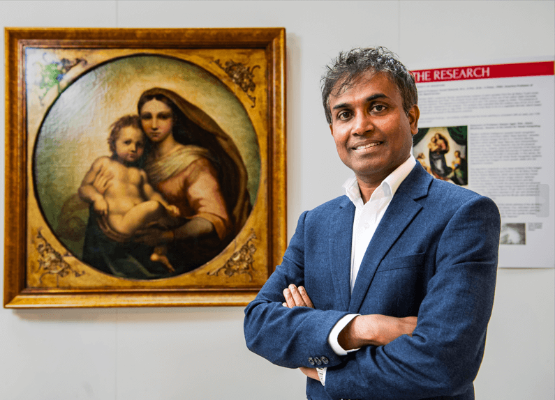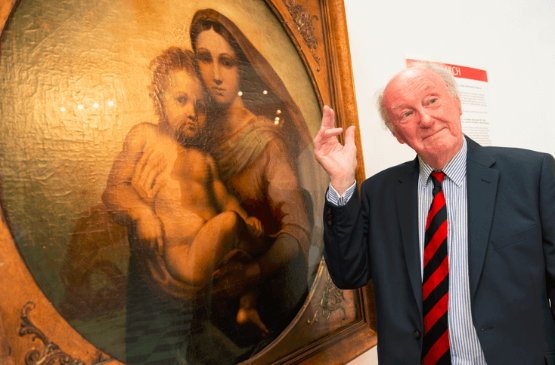AI study shows Raphael painting was not entirely the Master's work
A Raphael painting long debated by art historians features a face NOT created by the Renaissance master, according to new Artificial Intelligence analysis.
Professor Hassan Ugail, Director of the Centre for Visual Computing and Intelligent Systems at the University of Bradford, has devised an algorithm which recognises authentic works by Raphael, with 98 per cent accuracy.
He tested the Madonna della Rosa (Madonna of the Rose) using artificial intelligence-based deep feature analysis, which concluded that while most of the painting is indeed by Raphael, the face of Joseph is most likely not by the same hand.
A peer-reviewed paper on the work, titled Deep Transfer Learning for Visual Analysis and Attribution of Paintings by Raphael, co-authored by Professor Ugail, Professor Howell Edwards (Emeritus Professor of Molecular Spectroscopy, University of Bradford), Professor Christopher Brooke (a Fellow of the Society of Antiquaries of London and historian of ecclesiastical art and architecture, University of Nottingham) and Stanford University Adjunct Professor David G. Stork has been published today. Thursday 21 December, in Heritage Science journal.

Professor Ugail said: “When you present an image to the computer, it will give a binary classification of whether it’s an authentic Raphael or not, with 98 per cent accuracy. Now we can say with great confidence whether a painting is an authentic Raphael or not.
“When we tested the della Rosa as a whole, the results were not conclusive. So, then we tested the individual parts and while the rest of the picture was confirmed as Raphael, Joseph’s face came up as most likely not Raphael.”
Professor Ugail has previously used artificial intelligence-assisted computer-based facial recognition on a mystery painting known as the de Brécy Tondo (pictured with Professor Ugail above), which bears a resemblance to Raphael’s Sistine Madonna. The computer determined it was a work by Raphael, building on previous pigment analysis by Professor Howell Edwards, also at the University of Bradford, which placed it firmly in the Renaissance era.
Professor Ugail said: “The previous work concentrated solely on faces, but this new algorithm looks holistically at the entire painting.”
Madonna della Rosa
The della Rosa, which hangs in the Museo del Prado, Madrid, Spain, has intrigued art experts, with some - including Raphael scholar Professor Jurg Meyer zur Capellen - suggesting Raphael's pupil Giulio Romano may have contributed. One theory is that the rose and the lower portion may have been painted by someone else.
However, Professor Ugail’s analysis reveals the lower part of the painting is “most likely” by Raphael.
He said: “Using deep feature analysis, we used pictures of authenticated Raphael paintings to train the computer to recognise his style to a very detailed degree, from the brushstrokes, the colour palette, the shading and every aspect of the work. The computer sees far more deeply than the human eye, to microscopic level.
“This is not a case of AI taking people's jobs. The process of authenticating a work of art involves looking at many aspects, from its provenance, pigments, condition of the work and so on. However, this sort of software can be used as one tool to assist in the process.”
The Haddo Madonna
Another artwork Professor Ugail tested was a painting dubbed the 'Haddo Madonna,' which hangs in Haddo House, Aberdeenshire, managed by the National Trust for Scotland. It was acquired as a genuine Raphael by George Gordon, 4th Earl of Aberdeen, who was Prime Minister from 1852 to 1855. The painting, pictured below, was later queried and attributed to Innocenzo da Imola, and in 1899, given a valuation of just £20 - just over £2,000 in today's money. In 2016, historian Dr Bendor Grosvenor claimed on BBC's Britain's Lost Masterpieces that the painting was by Raphael. This claim was then rejected by experts at The National Gallery, London.
Professor Ugail's algorithm supports Dr Grosvenor's claim that the painting is most likely a work by Raphael.
-(1)-555x781.png)
To test the algorithm further, Professor Ugail commissioned painter Steven Seward to recreate a Raphael self-portrait. Professor Ugail said: “It’s an amazing piece of work by Steven. When you see the two paintings together, it is hard to see the difference. However, the computer concluded it was not authentic Raphael.”
A peer-reviewed paper on the work, titled Deep Transfer Learning for Visual Analysis and Attribution of Paintings by Raphael, co-authored by Professor Ugail, Professor Edwards, Professor Chris Brooke, University of Nottingham and Stanford University Adjunct Professor David G. Stork has been published in Heritage Science journal..
Quotes from co-authors:
Professor Edwards, Emeritus Professor of Molecular Spectroscopy, University of Bradford, pictured below at the world-first exhibition of the Tondo, said: "Painted on canvas around 1517/18, the Madonna della Rosa was regarded by early connoisseurs as a Raphael autograph, ie he painted 100 per cent of it. From the mid 1800s, the art historian Johann David Passavant and others questioned its composition and preferred to attribute its execution partially to Raphael and partially to his workshop.
"The attribution to Raphael’s workshop was gradually accepted later and attributed particularly to his pupil Giulio Romano and possibly also to Gianfrancesco Penni. In Spain the original attribution has never been questioned.
"Some connoisseurs regard the quality of the composition and painting for the Madonna, Child and St John as far exceeding that of St Joseph, whom they feel has been added at the workshop as somewhat of an afterthought.
"The AI programme analysis of our work has demonstrated conclusively that whereas the three figures of the Madonna, Christ Child and St John the Baptist are unequivocally painted by Raphael, that of St Joseph is not and has been painted by someone else – possibly by Romano, as believed by zur Capellen and others."

Stanford University Adjunct Professor David G. Stork, a pioneer in the application of computer vision to problems in the history and interpretation of fine art paintings and drawings, also contributed to the recent research. He agrees with Professor Ugail that this type of analysis is one tool in the process of authenticating a piece of art, to be used in conjunction with traditional methods.
Dr Stork, author of Pixels & paintings: Foundations of computer-assisted connoisseurship, said: "Computer methods are slowly but surely proving they can aid traditional humanistic studies of art, but they must always be employed with a deep understanding of art historical context, and their results understood and interpreted in the broader context of art knowledge relevant to the problem at hand.
"Art attribution and authentication are some of the most vexing and challenging tasks faced by art scholars who must study provenance (the documentary record of ownership, sales, and exhibitions of a work), material studies (chemistry of pigments, canvas, paper, varnish), the condition of the work (is it degraded over time or retouched), iconography (are the people and objects depicted appropriate), and finally connoisseurship (close visual study of brush strokes, colour, composition, and more).
"Most computer studies in art - including the current study - have focused on enhancing connoisseurship. The current study's results should not be taken as sufficient for an authentication decision, but a step toward improving overall authentication protocols. Some of the most successful computer studies of art have exploited large databases of art images to learn an artist's style and other properties. As such databases grow, computer algorithms are refined, and most importantly, as humanistic art scholars criticise and refine computer methods, computer methods will improve and become widely used throughout art history and criticism."
Co-author Professor Christopher Brooke, University of Nottingham, a Fellow of the Society of Antiquaries of London and historian of ecclesiastical art and architecture, said: "This analysis of art works by the artist Raphael presents an objective and quantifiable approach, using machine learning, to the classification of painted imagery.
"It promises to be a useful, additional tool in future investigations of this nature, alongside well-established methods such as spectroscopy.
"It is adaptable in that works by other artists may be examined using the same technique, and this is the goal of future research."
In the interests of science, Professor Ugail has released the code for his algorithm, so it is available to the public to replicate and test his work.
